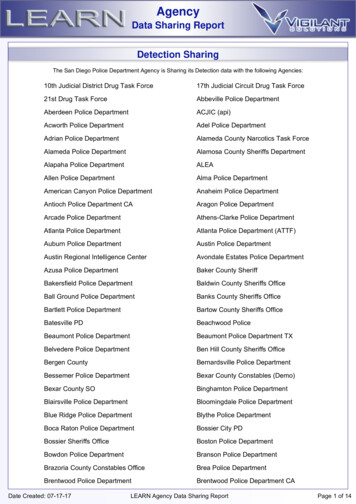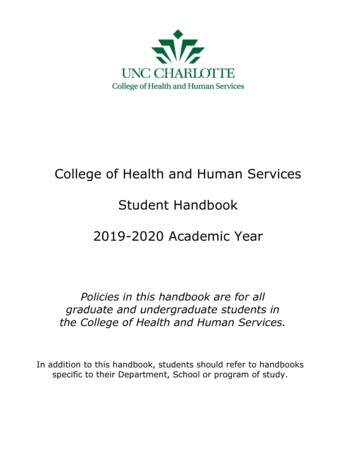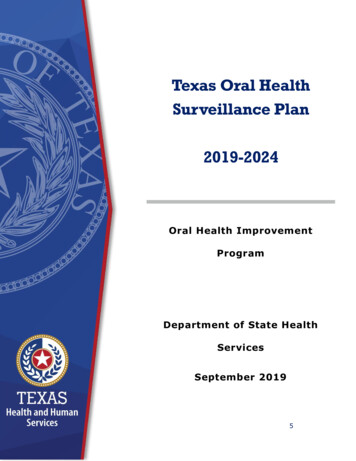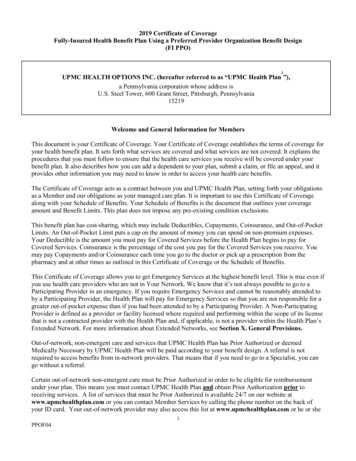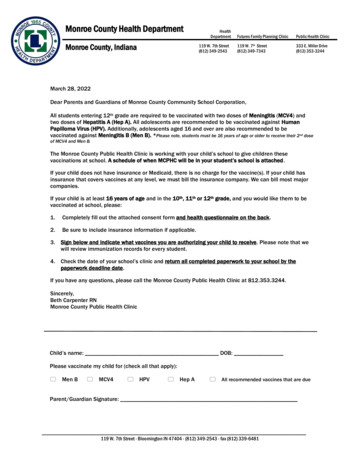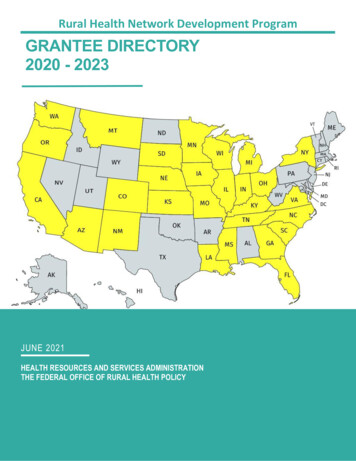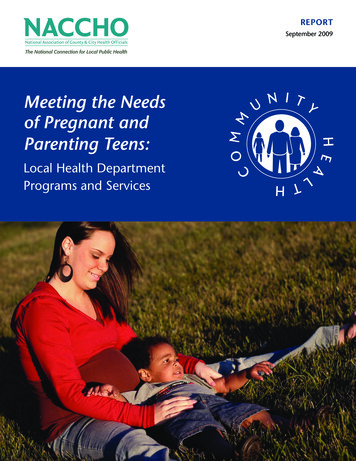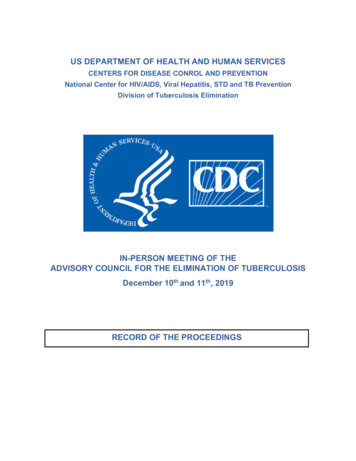
Transcription
US DEPARTMENT OF HEALTH AND HUMAN SERVICESCENTERS FOR DISEASE CONROL AND PREVENTIONNational Center for HIV/AIDS, Viral Hepatitis, STD and TB PreventionDivision of Tuberculosis EliminationIN-PERSON MEETING OF THEADVISORY COUNCIL FOR THE ELIMINATION OF TUBERCULOSISDecember 10th and 11th, 2019RECORD OF THE PROCEEDINGS
Table of ContentsMinutes of the In-Person Meeting . 1Day 1 Opening session . 2DTBE Director’s Update . 3NCHHSTP Director’s Report . 9Project ECHO’s Support to TB Activities. 13Update from TB Centers of Excellence . 16LTBI Communications Campaign Update . 19ACET LTBI Workgroup Update . 22Host-Directed Approaches to TB Therapy . 29Update from Division of Global Migration and Quarantine . 33Day 2 Opening session . 36Essential Components Workgroup Updates . 36LTBI Workgroup . 36TB Drug Supply Workgroup. 37ACET Business Session . 40Business Item 1: Approval of Previous ACET Meeting Minutes . 40Business Item 2: Advice Requested from ACET . 40Business Item 3: Report from the Board of Scientific Counselors, Office of Infectious Disease . 41Business Item 4: Public Charge Rule . 41Business Item 5: Response from HHS . 41Business Item 6: ACET’s Semi-Annual Report to HHS Secretary. 42Future Agenda Items . 43Public Comment Session . 44Closing Session . 44Attachment 1: Day 1 Participants’ Directory. 45Attachment 2: Day 2 Participants’ Directory. 47Attachment 3: Glossary of Acronyms . 49
US DEPARTMENT OF HEALTH AND HUMAN SERVICESCENTER FOR DISEASE CONROL AND PREVENTIONNational Center for HIV/AIDS, Viral Hepatitis, STD and TB PreventionDivision of Tuberculosis EliminationADVISORY COUNCIL FOR THE ELIMINATION OF TUBERCULOSISDecember 10th and 11th, 2019Minutes of the In-Person MeetingThe United States (US) Department of Health and Human Services (HHS) and the Centers forDisease Control and Prevention (CDC), National Center for HIV/AIDS, Viral Hepatitis, STD andTB Prevention (NCHHSTP), Division of Tuberculosis Elimination (DTBE) convened a meeting ofthe Advisory Council for the Elimination of Tuberculosis (ACET). The proceedings were held onDecember 10 and 11, 2019 beginning at 8:30 AM EST.ACET is formally chartered under the Federal Advisory Committee Act (FACA) to provide adviceand recommendations to the HHS Secretary, HHS Assistant Secretary for Health, and CDCDirector regarding the elimination of tuberculosis (TB). The charter authorizes ACET to makerecommendations regarding policies, strategies, objectives and priorities; address thedevelopment and application of new technologies; provide guidance and review on CDC’s TBPrevention Research portfolio and program priorities; and review extent to which progress hasbeen made toward TB elimination.Information for the public to attend the ACET meeting was published in the Federal Register inaccordance with FACA regulations and rules. All sessions of the meeting were open to thepublic (Attachment 1: Participants’ Directory)Minutes of the Meeting:Advisory Council for the Elimination of TuberculosisDecember 10 -11, 2019 Page 1
Day 1 Opening sessionCarla Winston, PhD., M.AAssociate Director for Science, Division of Tuberculosis EliminationNational Center for HIV/AIDS, Viral Hepatitis, STD, and TB Prevention (NCCHHSTP) Centersfor Disease Prevention and ControlACET Designated Federal Officer (DFO)Dr. Winston called the meeting to order at 8:30 AM EST, welcomed participants and conducteda roll call to confirm attendance of the ACET voting members, ex-officio members and liaisonrepresentatives. She announced that ACET meetings are open to the public and all commentsmade during proceedings are a matter of public record. She informed the ACET members to bemindful of their responsibility to disclose any potential public conflict of interest (COI), asidentified by the CDC Committee Management Office and recuse themselves from voting orparticipating in discussions where they have a conflict.Dr. Winston made announcements regarding the changes in ACET membership since theprevious meeting in August 2019. Meeting participants were asked to welcome the following new ACET members: Mr. Marc Gaudreau, who is the Manger for the TB Task Group, Public Health Agencyof Canada. He is representing Dr. Howard Njoo who serves as ACET LiaisonRepresentative. New ex-officio member, Dr. Lawrence Kline of the US Section, US-Mexico BorderHealth Commission. He replaces Dr. Bruce San Filippo CDC sent a letter to the Substance Abuse and Mental Health ServicesAdministration (SAMHSA) with a request to identify a replacement, on August 16th,2019 CDC sent a letter to the Office of Minority Health Substance Abuse and MentalHealth Services Administration (SAMHSA) with a request to identify a replacementon April 24th, 2019 CDC sent a letter to the Agency for Health Care Research and Quality with a requeston October 26th, 2019ACET Voting Member(Institution/Organization)Ana Alvarez, MDPotential Conflict of InterestNo conflicts disclosed(University of Florida College of Medicine)Robert Belknap, MD(Denver Metro Tuberculosis ControlProgram)Minutes of the Meeting:Advisory Council for the Elimination of TuberculosisDecember 10 -11, 2019 Page 2No conflicts disclosed
ACET Voting Member(Institution/Organization)Potential Conflict of InterestNo conflicts disclosedBarbara Cole, RN, MSN, PHN(Riverside County Department of PublicHealth)No conflicts disclosedJennifer Flood, MD, MPHCalifornia Department of Public Health)No conflicts disclosedDavid Horne, MD, MPH(University of Washington School ofMedicine)Robert Horsburgh, Jr., MD, MUSNo conflicts disclosed(Boston University School of Public Health)Lixia Liu, PhD, MP, (ASCP), D(ABMM)(Indiana State Department of Health)No conflicts disclosedKristine Steward-EastNo conflicts disclosed(Advocate for Tuberculosis)No conflicts disclosedZelalem Temesgen, MD(Mayo Clinic Center for Tuberculosis)The roll call confirmed that the 19 voting members and ex-officio members in attendanceconstituted a quorum for ACET to conduct its business on December 10th, 2019.DTBE Director’s UpdatePhilip LoBue, MD, FACP, FCCPDirector, Division of Tuberculosis Elimination (DTBE), NCHHSTPDr. Philip LoBue, Director of DTBE, provided updates encompassing budget, guidelinesupdates, the Food and Drug Administration (FDA) Drug Shortages Task Force Report, a followup on the National Institutes of Health and Centers for Disease Control and Prevention(NIH/CDC) TB Research meeting and selected DTBE accomplishments in 2019. He noted thebudget for Fiscal Year 2020 was currently in its second Continuing Resolution. Level fundingwould be provided until December 20, 2019 based on the 2019 Fiscal Year budget, after whichthe onus would be on Congress and the Administration to decide on further budgetarydeterminations.He went on to share successes regarding the publication of TB guidelines: the AmericanThoracic Society, Centers for Disease Control and Prevention, European Respiratory Societyand the Infectious Diseases Society of America (ATS/CDC/ERS/IDSA) Drug-Resistant TBguidelines, published in the American Journal of Respiratory and Critical Care Medicine onMinutes of the Meeting:Advisory Council for the Elimination of TuberculosisDecember 10 -11, 2019 Page 3
November 15, 2019, and the Latent TB Infection Treatment guidelines, accepted by theMorbidity and Mortality Weekly Report (MMWR). He noted that the authors of the Latent TBInfection Treatment guideline were currently responding to initial comments from MMWReditors. Following these revisions, a publication date would be generated, possibly in early2020. He offered kudos to the contributing authors, particularly as publication seemed unlikely inrecent years.The FDA Drug Shortages Task Force Report was published in October 2019. The reportidentified three root causes of drug shortages, namely, (1) a lack of incentives for manufacturersto produce less profitable drugs; (2) a lack of recognitions and reward for manufacturers for“mature quality systems” that focus on continuous improvement and (3) early detection ofsupply chain issues, and logistical and regulatory challenges that make it difficult for the marketto recover from a disruption and address the underlying issue. He mentioned that the full reportwas available on the FDA website and asked that colleagues at FDA correct anymisrepresentation of the report’s contents in his presentation. Dr. LoBue went on to highlight theTask Force’s proposed solutions to the root causes identified. First, there is a need to create ashared understanding of the impact of drug shortages on patients and the contracting practicesthat may contribute to shortages. Secondly, there is the need to develop a rating system toincentivize drug manufactures to invest in quality management maturity for their facilities. Heexplained that this rating would evaluate the robustness of a manufacturing facility’s qualitysystem and reward facilities that achieve a high degree of quality management and systemmaturity. Thirdly, the report outlined the need to promote sustainable private sector contracts tomake sure there is a reliable supply of medically important drugs. Dr. LoBue gave an examplefrom the report regarding contracts between purchasers and manufacturers, whereby contractscurrently include clauses that allow purchasers to break contracts if alternate manufactures offerlower cost medications. In such cases, manufacturers who have their contracts broken are leftcarrying inventory for which they have no purchaser. Such contracting practices make it difficultto manage supply and inventory.Lastly, the FDA report proposed initiatives to help curb the drug shortage problem. Theseinclude improved data sharing and a risk management plan requirement. With improved datasharing, the Task Force suggested a legislative proposal that would expand the informationrequired to be provided to the FDA when there is an interruption in manufacturing and authorizeFDA to impose penalties for failing to provide timely and adequate notification. The riskmanagement plan requirement would serve to provide FDA guidance for pharmaceuticalstakeholders to develop, implement and maintain a risk management plan for the purpose ofpreventing and mitigating drug shortages. The FDA report also proposed a legislativelengthening of expiration dates for drugs. This would authorize FDA to require, when likely toprevent or mitigate a shortage, that an applicant evaluate, submit studies to FDA, and label aproduct with the longest possible expiration date (shelf life) that FDA agrees is scientificallyjustified. The FDA report also proposed the initiation of technical and regulatory considerationsfor pharmaceutical product lifecycle management in the form of the International Conference onHarmonisation (ICH) Guideline Q12. This Guideline has to do with the harmonization ofregulations regarding drug production and approval internationally. Global implementation ofthis Guideline could facilitate the efforts of manufacturers who wish to modernize processes andMinutes of the Meeting:Advisory Council for the Elimination of TuberculosisDecember 10 -11, 2019 Page 4
equipment, but have found the regulatory landscape, particularly in industrialized countries,financially burdensome.Dr. LoBue provided a follow-up on the research meeting between the NIH and the CDC, held inJuly 2019. Dr. LoBue participated in a meeting at NIH held with the Chinese Academy ofMedical Sciences which was, essentially, a tuberculosis research symposium, aimed at servingas a platform for researchers from both countries to share their works and look for areas forfuture collaboration. Also, the CDC held a webinar with NIH to discuss collaborative work onPZA resistance. He also mentioned that there would be a joint NIH/CDC webinar on December13, 2019 discussing CDC novel bio-platform to identify pathogen and host directed therapies(HDT) against TB. He mentioned that there would be a more in-depth presentation on this toACET later in the day.Finally, Dr. LoBue presented selected 2019 DTBE accomplishments. The Division had a longlist of accomplishments and those presented during the meeting were selected because theyare relevant to issues discussed at ACET in the past or issues of interest to ACET. Hepresented accomplishments in categories as follows:Epidemiology and Clinical Science DTBE completed analysis and drafted manuscript on the study of the accuracy ofvarious LTBI tests, namely, QuantiFERON, T-SPOT, Tuberculin Skin Test (TST), inyoung children. He mentioned that the paper was currently going through the clearanceprocess at CDC. Key among study results is that the findings support the expanded useof interferon-gamma release assays in children of all ages because in a number of casesof non-US born children, Interferon Gamma Release Assays (IGRAs) work even betterthan TST.The Division completed enrollment in a randomized non-inferiority clinical trial thatcompared electronic directly observed treatment (eDOT) with traditional in-persondirectly observed treatment (DOT). DTBE should have results early next year. There hasbeen a lot of observational work in this area, which is highly supportive of the use ofeDOT, and various economic studies have supported cost savings. Dr. LoBuementioned that the randomized trial will help DTBE produce more rigorous reviews ofeDOT.DTBE also began enrollment for the Tuberculosis Trials Consortium (TBTC) study 37, aphase 3 clinal trial which compares 6 weeks of daily rifapentine versus 3-4 monthsstandard regimen of rifampin-based therapy for treatment of LTBI.Laboratory Science and Services DTBE has started work on the development of a novel 3-D cell culture model which useshuman monocytes and fluorescent protein-expressing Mycobacterium species to screenpotential host directed therapy. Dr. LoBue mentioned that there would be a presentationon this later in the meeting.As part of the CRyPTIC Consortium and 100,000 Genomes Project, DTBE collaboratedon a publication of a study assessing how well whole-genome sequencing performs forMinutes of the Meeting:Advisory Council for the Elimination of TuberculosisDecember 10 -11, 2019 Page 5
the detection of susceptibility to first-line anti-tuberculosis drugs. Dr. LoBue mentionedthat this was going to be important domestically as it will be in the future, in terms oflooking for ways to consolidate whole genome sequencing for both molecularepidemiology and testing for drug resistance. He mentioned that research could move toa single pathway for molecular testing.DTBE received and tested almost 1000 samples from 43 jurisdictions for drug resistancetesting.Program and Policy DTBE finalized the 2020 Report of Verified Case of TB (RVCT) and the messagemapping guide. Dr. LoBue mentioned that DTBE would be rolling these out in 2020,moving toward the new RVCT for updated case reporting.DTBE also published an evaluation showing that, over five years, the CDC-funded TBCenters of Excellence provided 14,586 expert medical consultation and traininghealthcare providers of TB patients.DTBE completed the Program to Expand Latent Tuberculosis Infection Testing andTreatment to High-Risk Communities in collaboration with Massachusetts Department ofHealth. The program screened 10, 000 patients, of whom 15% tested positive for TB. Hementioned that LTBI treatment and acceptance rates were quite high, with completionrates of approximately 80%.Communication and Education DTBE’s Communications and Education Branch has started developing and usingpersonal stories (videos and content). Within the past year, four patients with eitherlatent TB infection (LTBI) or TB disease have been invited to tell their story; one of thepersonal stories is in Spanish.A tremendous amount of work has been done around World TB day promotion andawareness activities. There have been over 50,000 visits to the webpages; resources onthe webpages have been downloaded over 5,000 times and the videos viewedapproximately 4,000 times.DTBE awarded funds via a new contract and cooperative agreement to develop a TBcommunity engagement network and communication campaign to raise awareness ofLTBI and increase testing and treatment among at-risk populations. Dr. LoBuementioned that Dr. Nick DeLuca would provide ACET with a more in-depth presentationon the TB community engagement network and communication campaign during themeeting.ACET Discussion: DTBE Director’s UpdateShortagesDr. Robert Horsburgh posed a question about FDA’s proposal to maintain a supply of drugs thatare not in great demand - for example drugs for multidrug-resistant Tuberculosis (MDR-TB). Dr.LoBue stated that he presented mainly highlights from the report but did not get a clearimpression of a plan for an incentive mechanism for such drugs. Dr. LoBue did not note aMinutes of the Meeting:Advisory Council for the Elimination of TuberculosisDecember 10 -11, 2019 Page 6
legislative proposal or recommendation in the FDA report regarding this concern. Dr. RobertHorsburgh indicated that there are special programs for orphan drugs but nothing similar thatprovides incentives to manufacturers for drugs with low demand, as far as he can tell. Dr. LoBueagreed and reiterated that the proposed incentives are meant to maintain a supply of drugs thatare already in supply, and not necessarily incentivizing manufacturers to bring new drugs to themarket or maintaining a drug that may not be profitable. Dr. LoBue asked Dr. Karen Elkins, USFood and Drug Administration, whether she had further insights. Dr. Elkins stated that Dr.LoBue’s response is a fair summary of the current situation. Dr. Elkins clarified that the orphandrug program is intended for manufacturers already in the process of developing a drug orbiologic for their own reasons, typically market driven, but this is not the same as inspiring amanufacturer to bring onboard a drug that does not exist or is still in the research process. Thisis a subset of the ongoing effort regarding drug shortages and targeting issues that are withinthe FDA’s control. Dr. Robert Horsburgh stated that, for providers, the priority is keepingavailability of drugs that are already approved and are in supply. Dr. Elkins answered that manyof the drugs that are in shortage are typically older drugs in shortage; there is no reason formanufacturers to be inspired to change the process. This report focuses on drugs that are inFDA’s wheelhouse.In terms of Dr. Jennifer Flood’s inquiry regarding FDA’s response to CDC’s letter to inquireabout the process with which the FDA report was developed, Dr. LoBue stated that CDC canexpect a specific response and responses to such specific inquiries would come from the“program”. The letter sought clarification regarding gaps and solutions that were not addressedin the report. Dr. Flood hoped that ACET would discuss this further during the TB Drug SupplyWorkgroup presentation. Dr. LoBue added that he had brought up these issues during ameeting where the FDA Task Force was present; the Task Force operates within a specificscope of work and some of the issues may be beyond this scope and hence not addressed. Dr.Jennifer Flood mentioned that it would be nice to have FDA leadership attend an ACET meetingand provide further details regarding timelines for the proposed solutions, publishing proposedratings for quality management, and lengthening expiry dates. Dr. LoBue stated that some ofthe proposed initiatives were legislative and FDA cannot predict timelines for these.Dr. Karen Elkins agreed that progress against the proposed initiatives would depend oncongressional action and increased funding. Dr. Elkins offered to act as a conduit and identifycontact persons who can address the concerns expressed (offline). Ms. Cole asked who wouldbe involved in this process, to which Dr. LoBue responded that this would be FDA’s Legislativeliaison. He reiterated that Dr. Elkins had offered to identify a point of contact to invite to ACET.Suzanne Marks offered additional DTBE updates, namely, the ATS/CDC/ERS/IDSA DrugResistant TB guidelines that CDC published. The guidelines have implications for practice.Secondly, TB- NCHHSTP Epidemiologic and Economic Modeling Agreement (NEEMA), amodeling consortium, has started a second (five-year) period of practice.With regards to Dr. Julie Higashi’s question about drug supply, clofazimine, and the possibility offuture discussions between FDA and Novartis, Dr. LoBue responded by indicating that thiswould have to be between FDA and Novartis. Ultimately, the decision would belong to NovartisMinutes of the Meeting:Advisory Council for the Elimination of TuberculosisDecember 10 -11, 2019 Page 7
and would have to go through the FDA regulatory process. Dr. Higashi stated that her concernstemmed from the substantial burden on jurisdictions and programs to get access to thesedrugs for drug-resistant TB. Dr. LoBue agreed with Dr. Higashi; however, he noted the currentregulations and laws give manufacturers the prerogative in this regard.Manuel, a participant on the telephone, questioned why the United States shares drug supplyproblems experienced globally, whereas Canada does not. Dr. LoBue responded by sharingthat, within the TB realm, shortages are not always caused by manufacturers, but rather themiddlemen in supply chain. Canada may operate differently.CDC/NIH MeetingWith respect to Dr. Horne’s question about whether TB vaccine testing was mentioned at theNIH/CDC meeting, Dr. LoBue indicated that this had been discussed at the meeting. Dr. LoBueadded that the CDC is open to this kind of research, but it would need to have domesticrelevance. CDC would be interested in looking at a post-infection vaccine that would preventreactivation. For CDC to invest in a late phase 2 or phase 3 clinical trial, there would have to bea good proof of concept to show that the effectiveness of the vaccine would need to becomparable to the effectiveness of LTBI treatment. Dr. LoBue added that there has beendiscussion about a recent vaccine published in the New England Journal of Medicine. Thevaccine was at 54% efficacy, which CDC considered to be too low, especially considering thatthe vaccine requires 2 doses administered one month apart. This would mean that 100% ofpeople may not complete the full dose, and therefore, the actual effectiveness would end upbeing in the high 40%s. This percentage is not very high when compared to current LTBItreatment. If a post-infection vaccine was developed that could replace 3HP (12-dose regimenof isoniazid-rifapentine) or 4R (4-month regimen of rifapentine), then CDC would consider thatvaccine.Dr. Mermin asked Dr. LoBue about his thoughts on conducting a study on short course dosetreatment or something that could be combined with a vaccine, to which Dr. LoBue respondedthat in order to be competitive, a vaccine would need to be single dose. The treatment wouldrequire pre-clinical work to demonstrate effectiveness. One can make theoretical arguments thatgiving drugs and reducing the organism burden works, but the combination could havedeleterious effect on the vaccine, since it requires immune response. CDC would need evidencefrom preclinical work of the efficacy of this treatment combination. Currently, there are no suchtrials; the limited research available does not provide enough evidence.Mr. Saraj Madoori asked whether the NIH/CDC collaboration would continue in 2020 and whatpotential future agenda items would include. Secondly, he inquired whether the BiomedicalAdvanced Research and Development Authority (BARDA) would possibly be included in theongoing collaboration. Dr. LoBue responded by pointing out that BARDA had been invited tosimilar discussion in the past, but no progress was made towards sustainable collaborationbecause the issues were outside of BARDA’s scope. Another attempt could be made to initiatea collaboration, but Dr. LoBue stated that he would not be overly optimistic about this.Minutes of the Meeting:Advisory Council for the Elimination of TuberculosisDecember 10 -11, 2019 Page 8
GuidelinesIn terms of David Horne’s question about whether the LTBI treatment guidelines included LTBIscreening guidelines in addition to regimen guidelines, Dr. LoBue answered that the guidelinesfocus on regimen guidelines. There are existing guidelines on LTBI screening from the UnitedStates Preventive Services Task Force (USPSTF) pertaining to non-US born persons. TheNTCA was also working on a companion document which would include answers to questionsof broader scope.NCHHSTP Director’s ReportJonathan Mermin, MD, MPH (RADM, USPHS)Director, National Center for HIV/AIDS, Viral Hepatitis, STD, and TB Prevention (NCCHHSTP)Dr. Jonathan Mermin opened his presentation with an overview of NCCHHSTP’s 2018 TBSurveillance Report. The report showed that the absolute number of TB cases on recordcontinues to slowly decrease, but not at the desired speed to meet elimination targets. Themajority of cases still come from four states - California, Florida, Texas, and New York.Ultimately, the biggest challenge in domestic TB elimination was expanding LTBI diagnosis andtreatment, which Dr. Mermin stressed would be the “job” of the next decade.The STD Surveillance Report showed that the number of cases of sexually transmitted diseases(STDs) have increased for the 5th consecutive year. In 2018, the combined number of cases ofsyphilis, gonorrhea, and chlamydia were at an all-time high: approximately 1.8 million cases ofchlamydia, 583,405 cases of gonorrhea, and 115,045 cases of syphilis. NCCHSTP hasconsidered the factors that may have contributed to the increasing rates shown in the report.While no rigorous analysis has yet been conducted, a contributing factor may be the reductionin the number and hours of operation of publicly funded STD clinics which occurred during theeconomic downturn and have not been reinstated despite improvements in the economy inrecent years. State and local health departments have not yet taken the opportunity afforded bythe improvements in the economy to invest in STD clinics and get services to the people whoneed them. Other contributing factors may include: the increase in syphilis which started almost10 years ago when serosorting among persons with HIV became more common; the decreasein condom use among vulnerable groups in the United States and youth in general; andincreased injection drug use and outbreaks of several diseases (e.g., syphilis) among peopleinjecting drugs. He mentioned that other countries are experiencing issues similar to the UnitedStates.Unfortunately, congenital syphilis cases have increased 40% from 2017 to 2018; there wereover 1,000 cases in 2018 with 100 deaths. Congenital syphilis continues to be a major issuefor mothers and infants, whose outcomes are quite severe. He mentioned that this situation can,potentially, be remedied with intervention and investigation into what has allowed this trend tooccur. It is a failure of healthcare system and society not to be able to prevent congenitalsyphilis. There is an increase in syphilis among young women of childbearing age, who are notpreventing themselves from getting syphilis or failing to obtain treatment in a timely fashion.Minutes of the Meeting:Advisory Council for the Elimination of Tuberculo
(Mayo Clinic Center for Tuberculosis) No conflicts disclosed The roll call confirmed that the 19 voting members and ex-officio members in attendance constituted a quorum for ACET to conduct its business on December 10 th, 2019. DTBE Director's Update . Philip LoBue, MD, FACP, FCCP. Director, Division of Tuberculosis Elimination (DTBE), NCHHSTP
